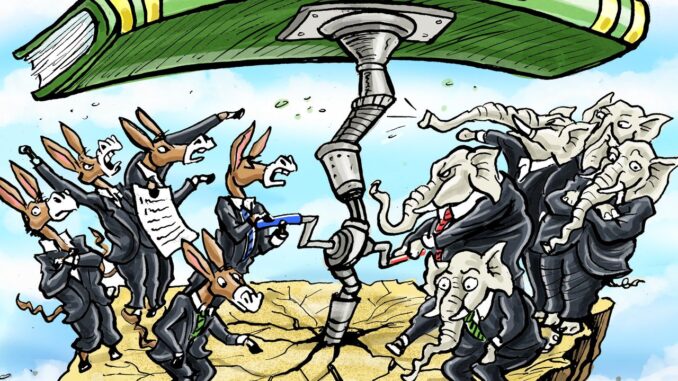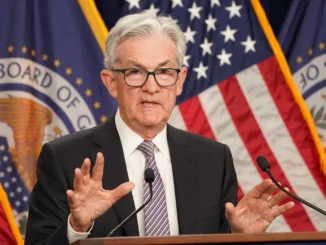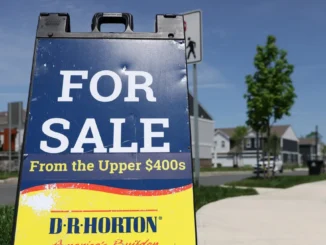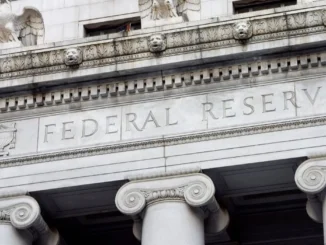
There’s a little bit of everything for economy watchers this week as data comes in on the housing market, first-quarter gross domestic product, inflation and consumer sentiment.
It’s also a week that could be influenced by key political moments such as the beginning of a civil damages trial in New York for former President Donald Trump, the expected announcement of a reelection campaign for President Joe Biden and an overseas trip to Japan, Israel and the U.K. by Florida governor and putative presidential candidate Ron DeSantis.
And, for added excitement and potential market volatility, there is also the chance of a House vote on Speaker Kevin McCarthy’s plan to handle the debt ceiling as the government nears the date on which it will run out of money to pay its bills.
Wall Street ended last week with a sigh of relief as the “systemically important” large banks reported first quarter earnings with little evidence that the banking crisis of mid-March had caused widespread damage to the industry or the economy.
“We didn’t hear anything on the calls or see anything in the numbers to make us abandon our view that households and businesses remain on solid footing,” BCA Research wrote on Monday. “Consumer delinquencies are still taking their time getting back to pre-pandemic levels; business non-performing loan and net charge-off ratios remain strikingly low; though they’re shrinking, consumer checking account balances are still far above their pre-COVID levels, supporting robust, albeit decelerating spending growth.”
As a result, BCA added: “The CEOs’ and CFOs’ commentary largely echoed last quarter’s and we interpreted it as confirmation of our view that an inflection in the business cycle is not just around the corner.”
The government will report the advance estimates of first-quarter growth on Thursday with consensus estimates just under 2% annually following the 2.6% level seen at the end of last year. The Federal Reserve Bank of Atlanta’s GDPNow model is currently at 2.5% with an update due on Wednesday. The estimate began the year under 1% and has been as high as 3.5%.
Data on the housing market will be plentiful, from S&P CoreLogic’s home price report for February on Tuesday and new home and pending homes sales reports coming Tuesday and Thursday, respectively. The three reports will likely show the housing market remains soft, beset by high mortgage rates and limited availability of homes for sale. Prices, meanwhile, continue to weaken from their 2021 and 2022 levels.
The week’s end brings an important read on inflation with the March personal consumption expenditures price index, a measure that the Fed pays close attention to. Estimates are for a continued decline in the rate of inflation as the monthly rate declines to a 0.1% rate of increase from 0.3% in February and the yearly pace falling to 4.1% from 5% a month earlier.
“Financial markets will weigh two questions next week: First, is inflation slowing? Friday’s releases of the Personal Consumption Expenditures Price Index, the Fed’s preferred measure of inflation, and the Employment Cost Index – many macroeconomists’ favorite measure of inflation from labor costs—will likely show that inflation is indeed slowing, though not fast enough to stop the Fed from hiking in May,” Comerica economists Bill Adams and Waran Bhahirethan, wrote on Friday.
“The market’s second question is whether the economy can dodge a recession after a year of aggressive rate hikes leading into the failures of Silicon Valley Bank and Signature Bank in March,” they added. “The first estimate of real GDP for the first quarter of 2023 will garner the most headlines. It will likely show slower but still positive growth following the fourth quarter of last year’s 2.6% annualized increase.”
Twin readings on the mood of the consumer will come Tuesday, with the Conference Board’s report on consumer confidence for April, and Friday when the University of Michigan issues its final estimate of consumer sentiment for the current month. Both have registered uneasy moods among consumers of late.
That unease is also seen in the markets, where there is currently a divergence in the outlook for inflation and Fed monetary policy. As inflation has come down from its peak in the 9% range last summer, the CME Group’s Fed Futures see an 89% likelihood of rate cuts before the end of the year totaling 75 basis points. The Kalshi Whisper, an unofficial model that reflects what banks are telling their clients and high net worth individuals, sees rates holding steady as the Fed completes one more rate hike in May of 25 basis points and only a 47% chance of a rate cut in 2023.
This sharp split between the two predictions is causing volatility in the markets as is sentiment over the fate of debt ceiling negotiations on Capitol Hill. Yields on ultra-short bonds have risen sharply as the “x” date by which the government technically runs out of money nears with some saying it could come as early as June. The 3-month Treasury bill was yielding 5.1% early Monday, while the 10-year Treasury was at 3.5%.
Normally, longer-term bonds yield higher returns as the economic outlook is harder to fathom the further off in the horizon it is. But the high yield on a short-term debt instrument is a reflection of nervousness over the immediate economic environment.
Spreads of five-year credit default swaps – insurance investors can buy against the chances of a bond default – are currently at 50 basis points, up from the 35 basis points they were at in January when the government breached the existing debt ceiling and as the Treasury announced emergency measures to continue paying the federal government’s bills.
It is not clear whether McCarthy has the votes to bring his debt ceiling bill, featuring a one-year extension of $1.5 trillion in exchange for cutbacks in government spending from a Biden administration that wants a clean increase in the limit, to a vote. If he does, it is likely dead on arrival in the Senate.
Source: www.usnews.com



